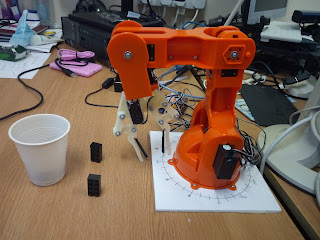Post 2 - Mobile Platform Prototype
Hi again, and welcome back to my blog.
Following on from my initial post last week, I thought I'd show the prototyping I've done with the mobile platform so far.
I started out by dismantling a radio control model I bought on e-bay as a non working spares-or-repair item. I bought this as I was only interested in stripping it down to the bare bones for a chassis for my mobile robot. I went with this approach as it got me the chassis, with built in battery compartment and loudspeaker, complete with the wheels and gearboxes for around £5.00, plus a couple of pounds P&P. An absolute bargain! The one I chose has quite a large base, ideal for mounting my electronics, and the upper housing is also quite roomy inside, so that when I'm happy with the electronics it can be refitted to give some protection. The photo's below show this stage of the conversion.
With the original electronics stripped out, I moved on to building my prototype replacement controller. I decided to do the construction on a breadboard while I am playing around with the design, then I'll do a soldered up version on stripboard when I have things as I want them. Here's a photo of the original design, using a Arduino Nano compatible controller board and a 'H' Drive integrated circuit. The chip I used has four driver circuits in it, so can drive 2 motors, independently, in forward and reverse. Here's how it looks lashed up in the chassis.
I propped up the back end of the chassis while I tested the controller and software, and confirmed that the motors rotated in the directions intended. The next step was to add an ultrasonic sensor board and test the unit as a whole. The video below shows the result.
It works quite effectively for the first trial, despite the ultrasonic range finder waggling around on the end of the connecting leads!
The next steps for this mobile platform are to add rotation sensors to the wheels and a radio transceiver board so that data can be streamed back to a PC to develop the mapping function. Probably add another couple of ultrasonic boards to assist with the mapping and make them more secure to improve the accuracy of the readings.
Be sure to check back to see the progress, and feel free to share with anyone who may be interested.
Following on from my initial post last week, I thought I'd show the prototyping I've done with the mobile platform so far.
I started out by dismantling a radio control model I bought on e-bay as a non working spares-or-repair item. I bought this as I was only interested in stripping it down to the bare bones for a chassis for my mobile robot. I went with this approach as it got me the chassis, with built in battery compartment and loudspeaker, complete with the wheels and gearboxes for around £5.00, plus a couple of pounds P&P. An absolute bargain! The one I chose has quite a large base, ideal for mounting my electronics, and the upper housing is also quite roomy inside, so that when I'm happy with the electronics it can be refitted to give some protection. The photo's below show this stage of the conversion.
 |
| The radio control board removed from model |
 |
| The chassis after removal of the RC board |
 |
| The upper housing - plenty of room for my electronics & a Ras Pi |
With the original electronics stripped out, I moved on to building my prototype replacement controller. I decided to do the construction on a breadboard while I am playing around with the design, then I'll do a soldered up version on stripboard when I have things as I want them. Here's a photo of the original design, using a Arduino Nano compatible controller board and a 'H' Drive integrated circuit. The chip I used has four driver circuits in it, so can drive 2 motors, independently, in forward and reverse. Here's how it looks lashed up in the chassis.
 |
| Robot controller lashup in chassis |
I propped up the back end of the chassis while I tested the controller and software, and confirmed that the motors rotated in the directions intended. The next step was to add an ultrasonic sensor board and test the unit as a whole. The video below shows the result.
It works quite effectively for the first trial, despite the ultrasonic range finder waggling around on the end of the connecting leads!
The next steps for this mobile platform are to add rotation sensors to the wheels and a radio transceiver board so that data can be streamed back to a PC to develop the mapping function. Probably add another couple of ultrasonic boards to assist with the mapping and make them more secure to improve the accuracy of the readings.
Be sure to check back to see the progress, and feel free to share with anyone who may be interested.



Comments
Post a Comment